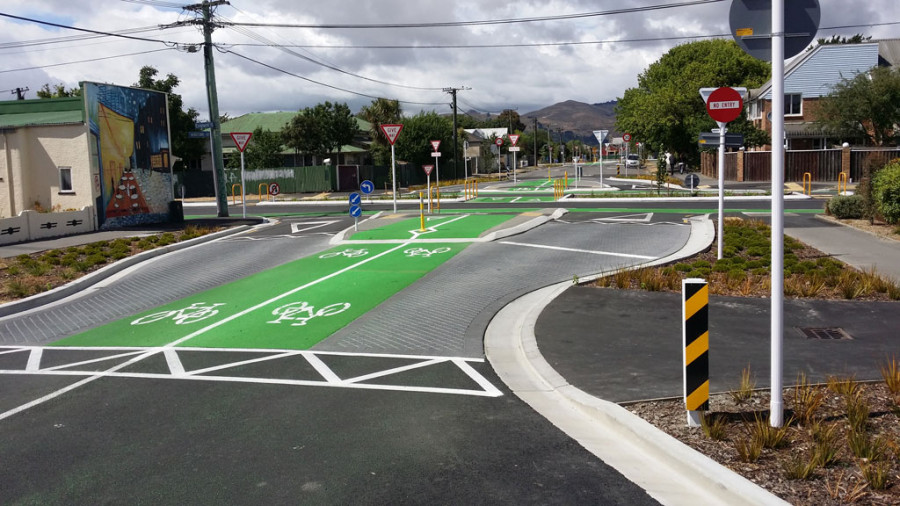Neighbourhood greenways, also known as ‘quiet streets’, ‘slow streets’ and ‘bicycle boulevards’, are streets with low volumes of motor traffic travelling at low speeds; this creates a pleasant cycling environment, without requiring specific cycle facilities.
Neighbourhood greenways commonly incorporate low speed limits and, more importantly, physical measures to ensure low speed environments. Physical measures may be used to restrict the movements available to motorists travelling in and out of a neighbourhood greenway, thus controlling vehicle volumes, whilst still allowing permeability for cycling.
Ideally, neighbourhood greenways should have motor vehicle volumes of no higher than 1,500-2,000 vehicles/day (and 150-200 vehicles in the peak hour), and vehicle speeds no higher than 30 km/h. Higher traffic volumes may be feasible in some very low speed environments. Auckland’s Local Path Design Guide(external link) presents a number of tools that can be used to convert a street to a neighbourhood greenway.
Neighbourhood greenways should be designated using way-finding signage and markings. As no specific cycle facilities are used, sharrows (‘share arrows’) are a useful tool to indicate that motorists should expect cyclists to be sharing the lane. Note that, while sharrows are a useful tool for neighbourhood greenways, their application is not limited to neighbourhood greenways. Sharrows may also be suitable for situations with higher traffic speeds and / or volumes than are appropriate for neighbourhood greenways.
The USA Transportation Research Board workshop summary on Neighbourhood Greenways(external link) provides a useful portal of guidance in this area.

Check whether a neighbourhood greenway is a suitable facility for your target users and for the type of road. |
As a neighbourhood greenway is a legal road any traffic control devices used within the roadway will be subject to the Traffic Control Devices (TCD) Rule and Road User Rule. It is important to check that any traffic control devices used (ie signs, symbols, markings, traffic calming device, marking or road surface treatment) comply with these rules. Treatments used in a neighbourhood greenway may need to be added to the local traffic bylaws, for example, the creation of one-way sections of road, banning of turns at intersections and speed limit changes.
CloseOverall guidance
Austroads does not specifically identify neighbourhood greenways as an option for providing for cycling, but does offer guidance on traffic management devices and diversion to support local area traffic management schemes.
In New Zealand neighbourhood greenway guidance is available in the Christchurch City Council Major cycleway design guide [PDF, 4.7 MB].
Auckland Transport have developed a Local Path Design Guide(external link) (‘local path’ being their terminology for neighbourhood greenways) that presents a number of tools for developing neighbourhood greenways.
Internationally, the NACTO Urban Bikeway Design Guide(external link) guidance for ‘Bicycle Boulevards’ can be suitably adapted to design neighbourhood greenways in New Zealand.
Contra-flow cycling
A neighbourhood greenway might involve a street that is one-way for motor vehicles but allows people to cycle in either direction (via a contra-flow cycle lane or separated path). The traffic control should be established by a local bylaw. For design considerations and signs requirements, see the guidance on provision for contra-flow cycling.
Close
Signs
Traffic control devices introduced on a neighbourhood greenway may involve traffic signs, including regulatory speed limits. Special information or destination signs to define a neighbourhood greenway and to provide wayfinding may also be developed.
Markings
Traffic control devices introduced on a neighbourhood greenway may involve road markings.
In particular, sharrow road markings (as specified in M2-3B of the TCD Rule) may be used to indicate to motorists that the traffic lane is shared if narrow lanes are part of the design. As no specific cycle facilities are used, sharrows are a useful tool to indicate that the available space is to be shared between cyclists and motor traffic. Some users may also interpret the position of the sharrow marking to indicate the best position on the carriageway for people on bikes to cycle.
The Sharrows Best Practice Guidance Note [PDF, 1.3 MB] outlines how sharrows should be applied, with key points being:
The New Zealand sharrows trial was completed in 2016 and formed the basis for adopting sharrows as an official traffic control device. More detail on the background and conclusions drawn from the trial is available:
Case study: Neighbourhood greenways, Portland USA
Case study: Rapanui – Shag Rock Cycleway | Puari ki Rapanui, Christchurch
Close